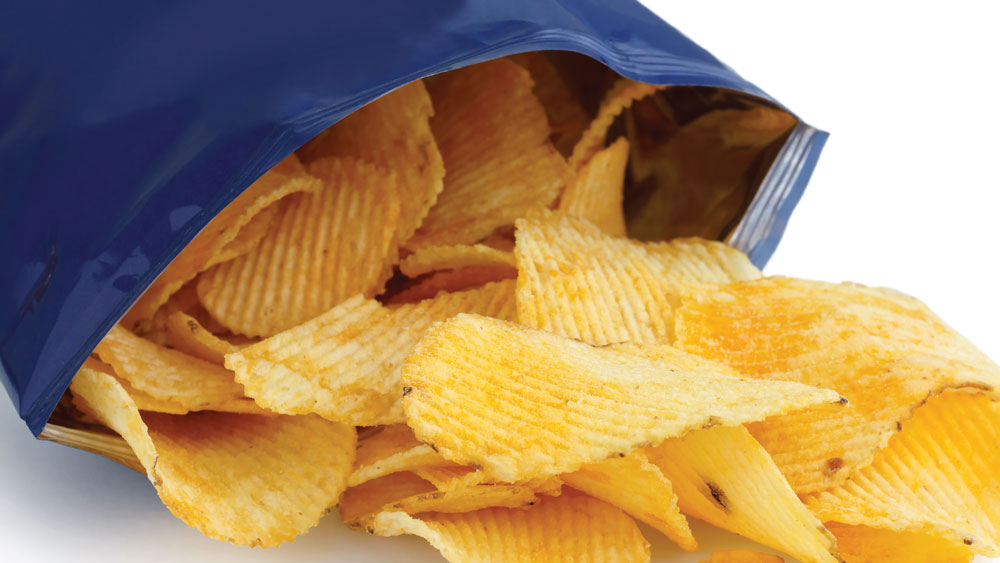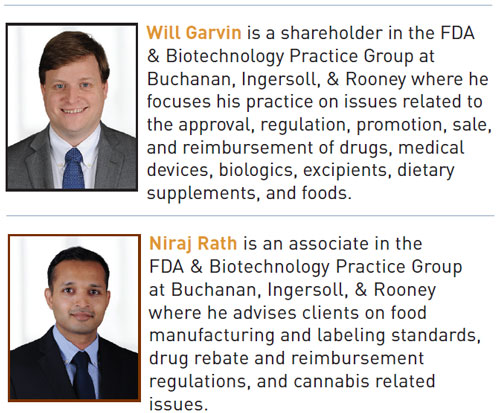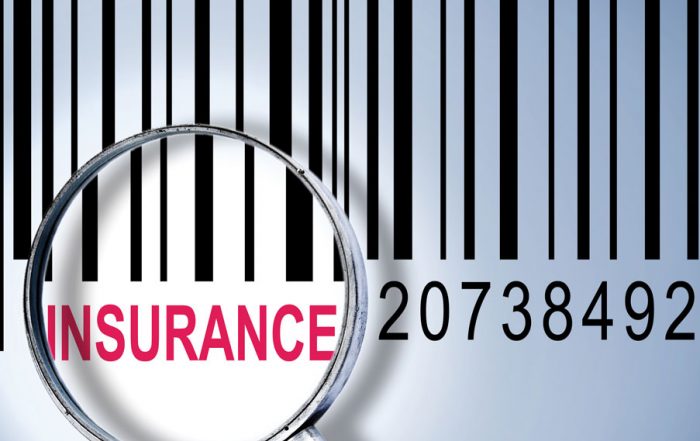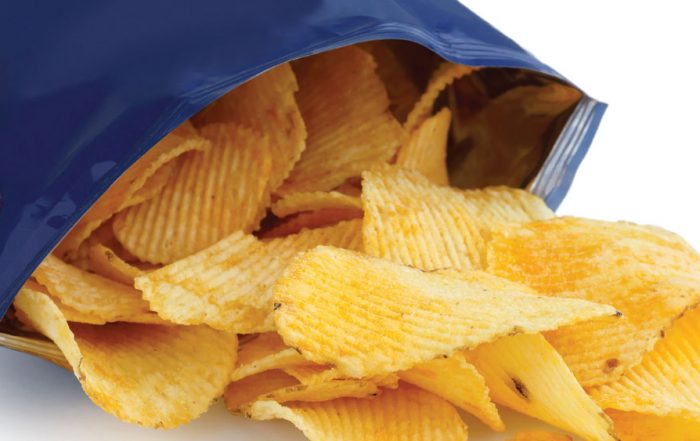
Regulatory Update on Acrylamide—State, Federal, and International Oversight
by Will Garvin and Niraj Rath
General Overview
Any food or food manufacturing process is subject to a wide range of risk, including risks from contaminants or carcinogens. While some of these risks are obvious and heavily regulated by both the Food and Drug Administration (FDA) and state administrative agencies, policies on other risks are still being developed and are not yet fully defined. One situation where the risks remain unclear from a regulatory perspective is with the chemical acrylamide.
Acrylamide is a chemical often found in industrial processes and has many uses ranging from the production of plastics and dyes to the treatment of drinking water.1 While desirable for those situations, the chemical becomes an unwanted byproduct that results from heating certain foods to above a certain temperature (usually 120º C).2 This is largely due to the presence of asparagine, an amino acid, which turns into acrylamide if surrounded by certain sugars during the heating or cooking process.3
 Acrylamide is of particular concern to manufacturers of foods that are subject to high temperature cooking such as baking, roasting, and frying.4 More specifically, companies that make potato products (e.g., french fries and potato chips), grain products, and coffee should have the greatest concern regarding acrylamide in their foods given the nature of how those foods are processed.5
Acrylamide is of particular concern to manufacturers of foods that are subject to high temperature cooking such as baking, roasting, and frying.4 More specifically, companies that make potato products (e.g., french fries and potato chips), grain products, and coffee should have the greatest concern regarding acrylamide in their foods given the nature of how those foods are processed.5
This article will review the current regulatory landscape of acrylamide on the U.S. federal, state, and international levels, with a special emphasis on California’s Proposition 65 regulations where a significant amount of guidance has been provided.
Regulatory Challenges
California’s Proposition 65
Proposition 65 (Prop 65; originally an initiative and later formalized as the Safe Drinking Water and Toxic Enforcement Act of 1986) was passed with a focus on keeping California consumers informed of the dangers of chemicals contained in the everyday products they purchase.6 The Office of Environmental Health Hazard Assessment (OEHHA) is the agency responsible for enforcing Prop 65 in California and keeps a running list of such chemicals. Specifically, OEHHA flagged acrylamide twice for its effects: first, in 1990 for producing cancer in lab animals, and second in 2011 for its effect on reproductive health.7 From there the agency has regulated the amount of acrylamide in foods in a variety of ways.
Legal Limits
California has set quantifiable limits with regard to an acceptable level of acrylamide in its foods.
First, under the No Significant Risk Level (NSRL)8 limit, California states that an acceptable level of acrylamide is capped at 0.2 micrograms per day.9 Anything above this amount would require a Prop 65 warning—a specific statement on the product itself notifying the customer that the consumer is being exposed to a chemical (in this case, acrylamide). While the guideline is helpful, California does not provide a specific level for a given product. From a practical perspective, this can pose problems for manufacturers since lab results may be given as parts per billion (ppb)— a measure of concentration (specifically micrograms per liter) that reflects the amount of acrylamide in a given volume. In contrast, the regulation’s metric of “micrograms per day” is a measure of intake by a person, and reaching the threshold would depend on how much acrylamide is contained in each serving of a product, as well as the quantity of product a given individual consumes. Based on the ppb amount, a manufacturer could calculate how much acrylamide is in a serving of a product and use this as a gauge against the safe harbor level. Again, companies would also have to figure out how much of their product a reasonable person would consume to get an answer they are comfortable with for Prop 65 purposes.
Second, California also has a Maximum Allowable Dose Level (MADL) of 140 micrograms per day.10 The level is set to the maximum amount of acrylamide for which there is no observable reproductive effect.11 While technically this is another avenue for guidance, the practical result is that food manufacturers will likely still try to comply with the NSRL level above given that the MADL level is significantly higher.
Settlements and Other Legal Activity
In addition to the written guidance mentioned above, California has also come to various settlements with food manufacturers and vendors regarding Prop 65 acrylamide levels.
In August of 2007, the California Attorney General reached a settlement with KFC Corporation (makers of Kentucky Fried Chicken or KFC)12 to post warnings to consumers that their food (by virtue of its high temperature cooking) contained acrylamide. Prior to the government’s action, KFC had failed to include any such warnings that some of its items, primarily its fried and baked potato products, contained the chemical. In addition to the warnings, KFC was ordered to pay damages of $341,000 ($133,000 of which was directly allocated to Prop 65 enforcement), but was allowed to include this warning with other posters providing nutritional content.13 Thus all major chains that engage in a large amount of frying or baking are potentially subject to these kinds of damages and should factor in these costs when deciding to expand or set up new locations.
Similarly, in August of 2008, a settlement was also reached with various chip companies14 to reduce the acrylamide levels in some of their snack products. While some chip brands contained little risk of chemical exposure, other brands, such as Kettle’s “Cape Code Robust Russets,” contained extremely high amounts of acrylamide—around 7,000 ppb.15 As a result, California pushed companies to lower their amounts to what it considered an acceptable level: Frito-Lay, Inc. agreed to reduce their levels to 490 ppb; Kettle Foods, Inc. and Lance, Inc. agreed to reduce the levels in their foods to 275 ppb; and H.J. Heinz Company agreed to reduce levels to anywhere from 315-500 ppb. While not dispositive, these numbers provide some idea of what might prove to be safe to the state of California. More importantly, manufacturers of chip products have approximate cutoff levels that can be incorporated into their production processes.16
Even with the settlements listed above, Prop 65 is still a very active area for plaintiffs’ attorneys who will always look for those companies that heavily fry and bake their products. Decisions to place a warning will ultimately depend on the company’s size and how much money it would be willing to resolve/settle with a potential litigant. Prop 65 also requires any private litigant to give 60-days’ notice to an alleged violator of the filing of the lawsuit. California publishes a list of these filings online, which can be narrowed down by the specific chemical.17
August 2018 Regulations
While no specific acrylamide regulation has been passed by California, the state has required that “clear and reasonable warnings”18 should be placed on products that meet the Prop 65 standard, with the caveat that the manufacturer itself must determine whether it meets these requirements. What constituted “clear and reasonable” was often vague, leaving manufacturers to devise their own generic messages noting only that a “chemical” was present in the relevant food.19
On August 30, 2018, new amendments will go into effect that will give detailed rules as to how warnings should be listed.20 Depending on whether the chemical is a carcinogen, reproductive toxicant, or both, this may include placement of large warning symbols (a yellow triangle that contains an exclamation mark), the term “warning” in all capital letters, a reference to the specific chemical in the product, and/or other specialized content requirements.21 Such regulations would also apply to those producers who run into acrylamide related issues. Fortunately, manufacturers may still comply with the old rules up until the date above and for those with a specific judgment (as in the KFC and chip cases), the judicial warnings would still be deemed compliant.22
FDA Guidance
From a federal standpoint, FDA continues to research the effects of acrylamide in foods, even releasing a guidance document23 in March of 2016. This guidance also contains suggestions as to how companies may reduce their acrylamide levels in their manufacturing processes. FDA has also issued regulatory reports, requests for comments and scientific data, as well as exposure assessments.24 Additionally, in July of 2003, FDA sent a letter to the OEHHA25 indicating that mandating warning labels for manufacturers under Prop 65 might “confuse and potentially mislead consumers, both because the labeling would be so broad as to be meaningless and because the risk of consumption of acrylamide in food is not yet clear.”26 In its response the OEHHA promised it would “develop a regulation regarding appropriate warning messages” with regard to acrylamide.27 California has yet to issue a specific acrylamide regulation but, as discussed above, does have warning requirements both currently in place and forthcoming. Outside of the literature above, FDA has not issued any further guidance or regulatory action and continues to investigate the issue.
Non-U.S. Implications
For companies with an international footprint additional protections may be required to safeguard against acrylamide regulatory penalties. In particular, the European Food Safety Authority published a risk assessment of the chemical’s presence in food detailing what acrylamide does in the body and what constitutes a “tolerable dose.”28 In July 2017, the European Commission provided representatives of the Member States with a proposed regulation to reduce acrylamide in food, which has been unofficially accepted by the representatives. The regulation is now subject to approval by the Council and European Parliament. If the regulation passes, it could come into effect as quickly as spring of 2018.29 The Commission also has plans for further discussions on additional regulations such as a stated maximum acrylamide level.
Summary
Producers engaging in high-temperature cooking should closely monitor these regulatory issues going forward. It may also prove useful to implement changes to the manufacturing process directly in order to minimize the amount of acrylamide in their foods. Examples of such changes include random testing of cooked batches, working with suppliers to avoid harvest and transport during cold seasons, and avoiding reconditioning of products.
- Acrylamide in Food and Cancer Risk, National Cancer Institute (2008), https://www.cancer.gov/about-cancer/causes-prevention/risk/diet/acrylamide-fact-sheet (last visited Sep 5, 2017).
- Id.
- Id.
- Center for Food Safety and Applied Nutrition, Chemical Contaminants – Acrylamide Questions and Answers,
U.S. Food and Drug Administration Home Page (2016), https://www.fda.gov/food/foodborneillnesscontaminants/chemicalcontaminants/ucm053569.htm (last visited Sep 5, 2017). - Acrylamide and Cancer Risk, American Cancer Society (2016), https://www.cancer.org/cancer/cancer-causes/acrylamide.html (last visited Sep 5, 2017).
- Cal. Health & Safety Code §§25249.5 – 25249.13.
- Acrylamide, Proposition 65 (2015), https://oehha.ca.gov/proposition-65/general-info/acrylamide (last visited Sep 5, 2017).
Office of Environmental Health Hazard Assessment, No Significant Risk Level (NSRL) For the Proposition 65 Carcinogen Acrylamide No Significant Risk Level (NSRL) For the Proposition 65 Carcinogen Acrylamide – March 2005.available at: https://oehha.ca.gov/media/downloads/crnr/acrylamidensrl.pdf
Id. - Office of Environmental Health Hazard Assessment, Proposition 65 Proposed Maximum Allowable Dose Level (MADL) for Reproductive Toxicity for Acrylamide – February 2010, https://oehha.ca.gov/media/downloads/proposition-65/chemicals/madl022610.pdf.
- Id.
- Office of Environmental Health Hazard Assessment, Proposition 65 Proposed Maximum Allowable Dose Level (MADL) for Reproductive Toxicity for Acrylamide – February 2010, https://oehha.ca.gov/media/downloads/proposition-65/chemicals/madl022610.pdf.
- Id.
- KFC Corp. Agrees to Comply with Proposition 65 Warnings (2007), https://oag.ca.gov/news/press-releases/kfc-corp-agrees-comply-proposition-65-warnings (last visited Sep 6, 2017).
- Id.
- Atty. Gen. Brown Settles Potato Chip Lawsuit With Heinz, Frito-Lay & Kettle Foods, Attorney General (2008), https://oag.ca.gov/news/press-releases/atty-gen-brown-settles-potato-chip-lawsuit-heinz-frito-lay-kettle-foods (last visited Sep 5, 2017).
- Id.
- More recent settlements with California have been reached with regard to acrylamide (See also People v. Snyder’s of Hanover (Snak King), et al.: https://oag.ca.gov/sites/all/files/agweb/
pdfs/prop65/snyders.pdf); however the settlements with KFC and the chip companies still remain the most significant. - 60-Day Notice Search, State of California – Department of Justice – Office of the Attorney General (2017), https://oag.ca.gov/prop65/60-day-notice-search (last visited Sep 5, 2017).
- Notice of Adoption Article 6: Clear and Reasonable Warnings, OEHHA (2017), https://oehha.ca.gov/proposition-65/crnr/notice-adoption-article-6-clear-and-reasonable-warnings (last visited Sep 5, 2017).
- Notice of Proposed Rulemaking – Title 27 Article 6 Clear and Reasonable Warnings (2015), https://oehha.ca.gov/media/downloads/crnr/npr112715.pdf (last visited Sep 19, 2017).
- Supra, Note 17. See also, Side-By-Side Comparison of Old and New Regulatory Provisions of Title 27, Article 6 (2016), https://oehha.ca.gov/media/downloads/crnr/side-sidearticle6090116.pdf (last visited Sep 19, 2017).
- Side-By-Side Comparison of Old and New Regulatory Provisions of Title 27, Article 6, pg 10 (2016), https://oehha.ca.gov/media/downloads/crnr/side-sidearticle6090116.pdf (last visited Sep 19, 2017).
- Proposition 65, Clear and Reasonable Warnings, Questions and Answers for Businesses (2016), https://oehha.ca.gov/media/downloads/crnr/art6businessqa.pdf (last visited Sep 19, 2017).
- Center for Food Safety and Applied Nutrition, Guidance Documents & Regulatory Information by Topic – Guidance for Industry: Acrylamide in Foods U.S. Food and Drug Administration Home Page (2016), https://www.fda.gov/Food/GuidanceRegulation/GuidanceDocumentsRegulatoryInformation/ucm374524.htm (last visited Sep 5, 2017).
- Center for Food Safety and Applied Nutrition, Chemical Contaminants – Acrylamide U S Food and Drug Administration Home Page, https://www.fda.gov/food/foodborneillnesscontaminants/chemicalcontaminants/ucm2006782.htm (last visited Sep 19, 2017).
- Office of Environmental Health Hazard Assessment – California Environmental Protection Agency, Meeting of the Carcinogen Identification Committee– October 17, 2003, https://oehha.ca.gov/media/downloads/crnr/acrylbrief.pdf.
- Id at Tab 5.
- Id at Tab 5.
- EFSA Explains Risk Assessment – Acrylamide in Food, http://www.efsa.europa.eu/sites/default/files/corporate_publications/files/acrylamide150604.pdf (last visited Sep 5, 2017).
- Acrylamide: Vote in Favour of Commission’s Proposal to Reduce Presence in Food (2017), http://europa.eu/rapid/press-release_IP-17-2028_en.htm (last visited Sep 5, 2017).
Update Magazine
September/October 2017









